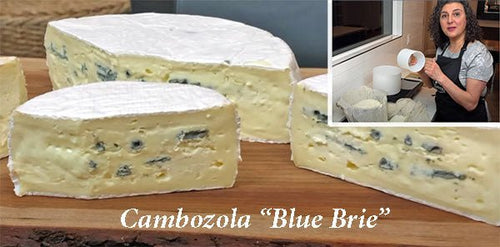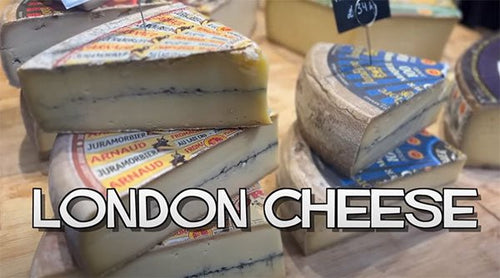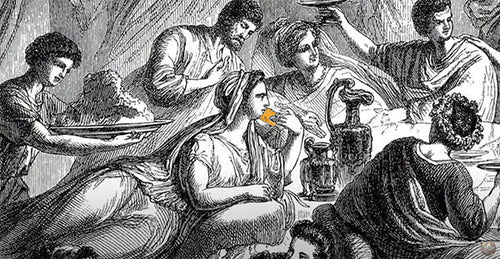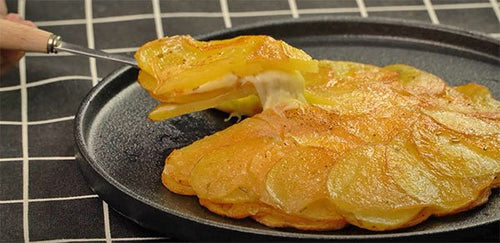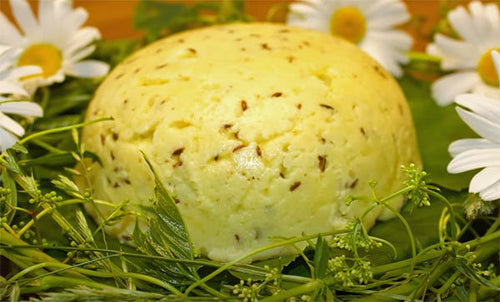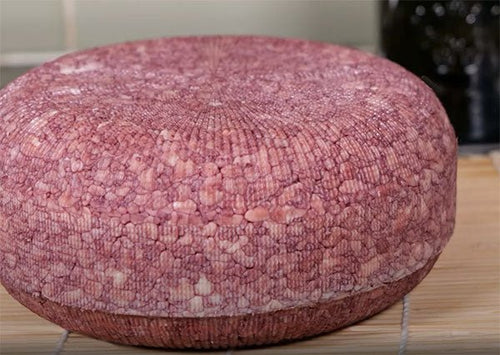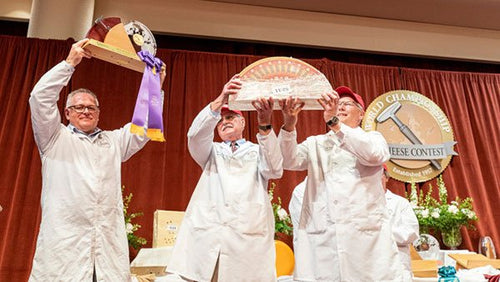Cheese Making Recipe of the Month
Gruyere
The great mountain cheeses of France and Switzerland
It is a class of cheese that contains the likes of Abondance and Beaufort. The cheese was traditionally made in the mountain meadows or alps, hence the term 'Alpage' for those still made this way.
This is a cheese similar to Ementhaller (the big wheels with holes) but does not undergo the warm room ripening that allows the gas to build up and create the holes.
Our Online pages for this cheese show you step by step with photos how to make this fabulous cheese. Including some very good pics on the proper curd set and some good information on the prepress.
We include the recipe details at the bottom of the pg just follow the chef.
New Online Moos-Letter
For over 27 years now Ricki Caroll has been spreading the word and showing people how to make fabulous cheese at home in their own kitchen. One of her strongest traits is that overwhelming energy to keep herself and everyone else excited about it all.
Here at 'Cheesemaking.com' we have always realized that the more we give the more we get back. A lot has happened over the past 27 years and the Web has been one of the biggest changes. It provides a much greater resource to access products and information. In the spirit of sharing this new technology we will be periodically publishing our online newsletter. We hope everyone enjoys it.
Cheese Making Questions & Answers
Q. Rennet Question? ... I have a question about rennet.
There are a number of options.. animal, animal derived, vegetable, liquid, tablet, powder, so many choices! Is one better than another for any particular reason?
A. .... Some tips on rennet....
liquid is a lot easier to work with than tablet because you can measure it very precisely, however the powder or tablet form will keep better under more adverse conditions...Calf rennet is still the best for longer aged cheese because some of it's residual components help to complete the breakdown of proteins.. some of these more complex proteins can have a bitterness thus leaving a bitter cheese....Some people have found that veg rennet can lead to this bitterness due to incomplete protein breakdown....In younger and medium aged cheese this is not such a problem so either can be used ...calf rennet is usually more expensive
Q. Raw Milk?... I would really like to make cheese from raw milk but I am not sure it is safe. Can you provide some guidelines?
A... The real story behind raw milk is that it has been used this way for hundreds of years... it was in the early/mid part of the 20th cent that pasteurization came into play... that was also the time that milk bulking and multiple day storage began in earnest... of coarse this led to milk quality problems
.... In other parts of the world (i.e. France, Italy), raw milk is used for making cheese today but in the US it is illegal to sell raw milk cheese in under 60 days...
... using your milk in the raw state is a personal decision based on your having an absolute confidence in the cleanliness of your milk ... If you do decide to use it, you might consider warning your friends of it's raw nature before serving .. especially if they are pregnant or have some type of immune system problem since these people are most at risk... if you are currently drinking this milk raw and have a good idea of a clean cheese making setup and process ... then I see no problem with using it ..but the final decision is yours
Q. What is the proper weight for pressing? ... My question is a pressing one - in Ricki's new book, the Farmhouse Cheddar instructions call for three stages of pressing...10 minutes at 10 lbs, 10 minutes at 20 lbs and then 12 hours at 50 lbs. The first two pressings don't remove much whey - minimal weight for minimal time, then there is a big jump to 50 lbs. I compared it to a Farmhouse cheese recipe in an old Cheesemakers Journal and the pressing times and weights were very different, made more sense and resulted in a better cheese. Wheats up?
A. What's up ... is that for many years we adapted factory recipes to the small scale of home cheese making... Now as weight goes, the old books had huge amounts of weight up to 5-10 tons per cheese and as we began to make more cheese at home (this hasn't been done like it used to) we began to realize that less weight was just as effective and resulted in cheese w/ better texture
Ricki's newest book reflects this. The low press weigh to start with begins to consolidate the curd and will not block the whey release. By the time you add the 50 lbs most of the whey has been pressed out ... in most cases this should suffice but perhaps w/ a drier cheese more weight for longer would be needed... my 10 lb cheese takes 250+ lbs but it is very dry for long term aging.
Essentially .. The drier and larger the cheese, the more weight required
Also less weight for a longer period in the latter stages of pressing may give you better results.
Have a cheese making question, we're here for you: info@cheesemaking.com
Meet a Fellow Cheese Maker
John & Janine Putnam from Thistle Hill Farm
in North Pomfret VT
Producing 'Tarentaise' Vermont Alpine Cheese
The search for the perfect cheese to match their land, herd, and style of doing things has taken John and Janine to the Savoie valley of France.
Here they have found in this mountain valley the cheese that met their needs.
However it was not to be made in Vermont in the industrial style but in the traditional way of the mountains. An age old process that would test their ambitions.
It involved learning as much as they could from the people in France and then applying it to their own farm in Vermont. It would mean seeking out a copper vat and convincing the American inspectors of it's need. It would also mean working with these same inspectors to help them understand the need to develop and use the traditional cultures that are so essential to this project.
And this was only the beginning.
It has been a few years now and their 'Tarentaise' has developed into one of America's great cheeses.
This year their cheese won the Blue Ribbon for Farmstead Cheese at the American Cheese Society Competition in Milwaukee WI.
What's New at Cheesemaking.com
Supplies, Equipment and Technical Support for the Farmstead and Artisan Cheesemakers
Ricki has teamed up with Jim Wallace to expand the services that she has been providing for over 27 years. Ricki still provides the same excellent service and support that she has for the home cheese-maker and Jim is picking up the middle ground by teaching Intermediate/Advanced classes for the farmstead artisinal cheese-maker as well as providing the companies expanded tech support.
Jim's background began in the sciences but for the past 25 years he has travelled in wild places making photographs. During these travels he has developed an interest in the 'old ways' and especially traditional cheesemaking. His current focus is to bring this to the home, farmstead, and artisinal cheesemaker
New England Cheesemaking Supply Company will be expanding it's range of cultures and equipment for the trade and the more advanced cheesemakers, carrying new pH meters, advanced acid testing kits, new molds, cloths and more.
2 ONGOING FEATURES
- The pictorial process of many wonderful cheeses designed to motivate and inspire. Jim researches and produces these traditional cheeses, and photographs the process which we will continue to share with you.
- Some of our favorite cheesemakers and what makes them unique will be shared as we have time.
- Mariano Gonzalez of Fiscalini Farm, CA was our first and will be followed by
- John and Janine Putnam of Thistle Hill Farm, VT. We will be adding more after the ACS conference in WI.
Take a look at our French Trip online it was wonderful!
New to Catalog
With an eye to helping out our cheese making friends we are continually updating supplies and equipment in our catalog to make life a little easier.
This issue features 2 new acidity testing devices and 2 new molds that we have added to our collection.
Acid Meter
If you need to measure actual % acid, this 'acid titration kit' is the best. Just squeeze the bottle to fill and push the button to dispense NaOH drop by drop or in a stream. This is much more accurate and easier to use than our 'acid testing kit'
If you are serious about controlling the quality of your cheese, this is the one you need.
pH Meter
The pH meter we have sourced has solved 2 of the big problems for cheese makers using pH meters.....the first is the problems of keeping the glass sensor clean... and the second is a simpler calibration method.
Tomme Cheese Mold
We have also added 2 new mold/follower combos to our line up. The first is a Large Tomme mold perfect for a small 4-5lb wheel such as a munster or Trappist style cheese.
Please send your cheese making news & photos to: moosletter@cheesemaking.com
























































































